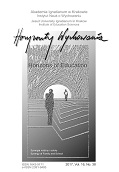Zaburzenia mowy a potrzeba porozumiewania się. O komunikacji alternatywnej i wspomagającej
Speech Disorders and the Need to Communicate. On Alternative and Augmentative Communication
Author(s): Magdalena JankoszSubject(s): Language studies, Language and Literature Studies, Communication studies, Health and medicine and law
Published by: Uniwersytet Ignatianum w Krakowie
Keywords: Speech; augmentative communication; alternative communication; functions of a language;
Summary/Abstract: RESEARCH OBJECTIVE: The aim of the article is to present selected issues related to speech disorders and the most important types of alternative and augmentative communication as well as to draw readers’ attention to the fact that these systems not only enhance communication but also fulfil other functions of a language. THE RESEARCH PROBLEM AND METHODS: Using the method of the analysis of subject literature and referring to the particular biographies described in the book Devoted (by D. Hoyt and D. Yeager, 2011) and in the film The Diving Bell and the Butterfly (directed by J. Schnabel, 2007), I presented the most common types of alternative and augmentative communication and compared them to Roman Jakobson’s communication model. THE PROCESS OF ARGUMENTATION: In the first part of the article I characterized speech as a biologically and socially conditioned phenomenon, which, at the same time, enables us to fulfil our higher, spiritual needs. Then, focusing on the issue of variously conditioned speech disorders, I presented the most common types of alternative and augmentative communication. I also used the examples from literature and films and referred to Jakobson’s model of a speech act to depict numerous functions fulfilled by this communication. RESEARCH RESULTS: Speech disorders pose a really serious difficulty for people affected by them, which is why it is crucial for them to learn different types of alternative and augmentative communication properly adjusted to their needs and abilities. The examples of alternative and augmentative communication given in the article fulfil all functions of a speech act listed by the author of Linguistics and Poetics, including not only the ones connected with sender, receiver, code, channel or context, but also functions directed towards a message itself, i.e. the poetic function. Alternative and augmentative communication enables people affected by speech disorders to interact, build personal and social relationships, express feelings and intentions or even undertake literary activity. CONCLUSIONS, INNOVATIONS AND RECOMMENDATIONS: It seems really important to expand the knowledge of alternative and augmentative communication methods. The problem of communication difficulties connected with various speech disorders affects many people who would suffer from social alienation if it was not for these methods. Also, literary attempts undertaken by people with speech disorders (e.g. blogging) should be acknowledged and popularized.
Journal: Horyzonty Wychowania
- Issue Year: 16/2017
- Issue No: 38
- Page Range: 109-123
- Page Count: 15
- Language: Polish

